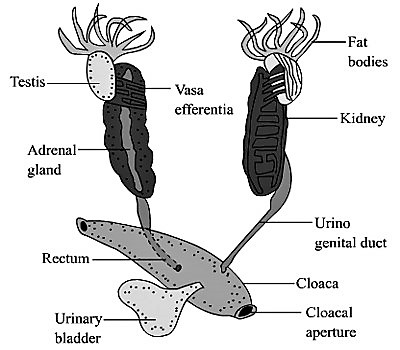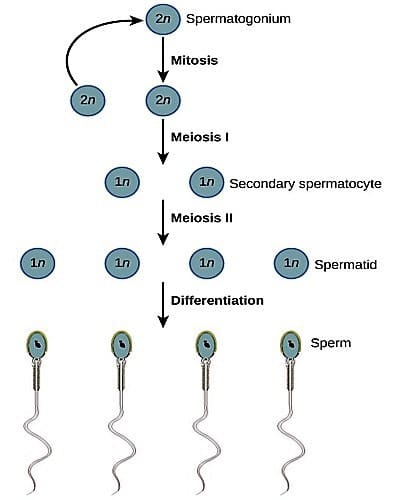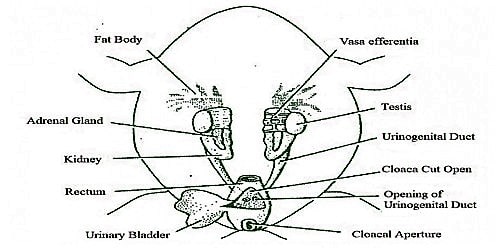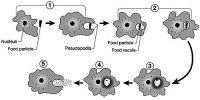The frog is a unisexual animal with simple sexual dimorphism. The reproductive system of a frog is dependable for producing gametes which are free in water for fertilization. Generally, female frogs are smaller than males of a similar age.
Frog male reproductive system:
The male reproductive system includes the following organs, a pair of testes, Vasa efferentia (10-12 in number) and a urinogenital duct that opens into the cloaca. The cloaca is a compartment which is used to pass the fecal matter, urine as well as sperms to the outer surface. The abdomen of the male frog is small and thin. Vocal cords are present in a male.
Frogs have well-organized male and female reproductive systems. Male reproductive organs consist of a pair of yellowish ovoid testes (Figure), which are found adhered to the upper part of kidneys by a double fold of peritoneum called mesorchium.

Vasa efferentia are 10-12 in number that arises from testes. They enter the kidneys on their side and open into Bidder’s canal. Finally, it communicates with the urinogenital duct that comes out of the kidneys and opens into the cloaca. The cloaca is a small, median chamber that is used to pass fecal matter, urine and sperms to the exterior.
The male reproductive system of frog consists of the following organs;
- Testes
A male frog’s testes rest close to his tail area, one on the front of each of his kidneys. It is one paired, yellowish color, oval formed which is surrounded by peritoneum and are close to the dorsal divider of the kidney. Parts of urinary ducts provide as vessels that produce semen and consent to the assortment of sperm. It consists of interstitial cells whose emission enables to show secondary sexual characters. When he mates, his sperm is released through the urinary ducts into his cloaca and then out of his body.
Sperm is formed of head, neck, and tail. The head is thick and inflated formation with acrosomes in its top which contains the similar sized nucleus. The neck joins head and tail parts which consist of centrosome and mitochondria. The tail is a thread like formation and helps in wriggling activities of sperm.
- Vasa efferentia
It is a group of 10-12 ducts that occur from the testis and opens into Bidder’s tube. Internally it is enclosed by epithelium and outwardly by connective tissues. At last, it opens cooperatively into a network of ducts known as rete testis.
- Seminal vesicle
Each urinogenital duct expands to appearance decisive vesicle where the sperms are stored until they are turned out throughout copulation.
Sperm formation
Spermatogenesis is defined as the development of sperm in the genital epithelium. It consists of four stages,

- Multiplication phase: Genital epithelium cell is divided by mitotic separation into numerous cells called spermatogonia. The chromosomes number remains similar as 24.
- Growth phase: The spermatogonia expand in their volume by engrossing nutrients and are called as key spermatocytes. The chromosomes number residue the similar.
- Maturation phase: Here, major spermatocyte forms two cells by meiotic separation. These cells are further divided and every primary spermatocyte is transformed into four secondary spermatocytes.
- Metamorphosis: This stage is the period of development of sperm, mitochondria, and centriole forms head, Golgi complex gives augment to acrosome and centriole forms tail and its cover are shaped from mitochondria.













